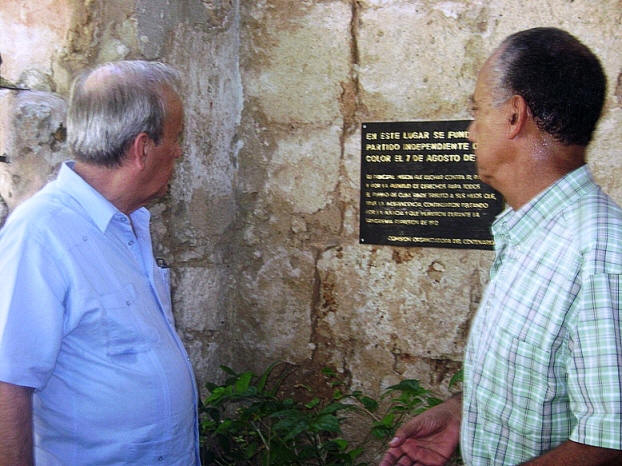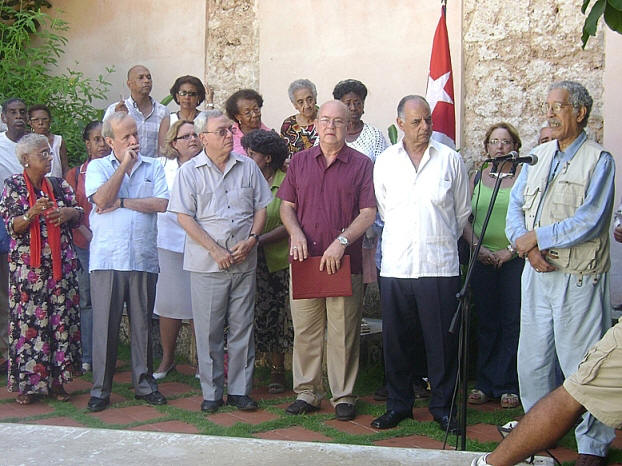| |
The Meaning of a Centennial
Fernando Martínez Heredia
A CubaNews translation by Odilia Galván Rodríguez.
Edited by Walter Lippmann.
This August 7 marks a century since a group of Cubans
founded a new political organization, the Independent
Party of Color (PIC), at 63 Amargura Street, in Havana.
They were black and mulatto activists opposed to the
racism that persisted in the country after the end of
slavery (1886) and the great national gesture of ’95,
which gave rise to the nation and the Republic. Blacks
and mulattos had continued to suffer a very
disadvantageous social situation, the legacy of slavery
and colonialism, plus a harsh brand of racism. The PIC
was made up of former Mambí combatants and humble
members of the population who had won their citizenship
and wanted to achieve more than that.
The objective of the PIC was to organize the struggle
for their specific rights, using legal channels for
public expression and elections. Its main leaders were
the veteran Evaristo Estenoz, Colonel Pedro Ivonet, a
hero of the Mambí invasion and the campaign of Pinar del
Rio, Gregory Surin, Eugenio Lacoste and others. The PIC,
which attracted thousands of followers throughout the
country, made social demands favorable for the entire
population of unassuming Cuba workers, preserved its
nationalist ideals and remained opposed to U.S.
imperialism.Since
its inception, the bourgeois neo-colonial power
relentlessly attacked the PIC, because it threatened
their hegemonic, liberal-conservative political
bipartisanship. The PIC, cynically accused of racism,
was declared illegal in 1910 by the Morúa Amendment to
the Electoral Law, with their leaders and activists
jailed for six months. Harassed and prevented from
utilizing the electoral process, on May 20, 1912 they
opted to launch an armed protest, on the tenth
anniversary of the establishment of the republic. The
government of José Miguel Gómez mobilized thousands of
soldiers against the PIC and its supporters, along with
a dirty campaign to demonize the in the press. During
June and July, Estenoz and Ivonet and at least three
thousand
non-white Cubans, mostly from Oriente province, the
focal point of the uprising, were killed. A wave
of repression, persecution and an intensification of
racism spread throughout the country. The official
republic carried out the great crime and immediately
sent the story into oblivion to which they
continued to add – due to the cruel necessity to survive
and to leverage some level of social advancement – the
most discriminated-against and dominated in that
society.
Last December, the
Communist Party of Cuba convened several dozen citizens
and formed the Committee to Commemorate the Centenary of
the Independent Party of Color in the country throughout
this year, 2008. Due to the interest of its members, in
little more than seven months the committee has done a
great deal of work. The activity and initiative of a
number of institutions and numerous individuals, not
listed here to avoid the risk of oversights, and because
we have not completed all of our efforts, are actually
gaining the strength to continue the work as long as is
necessary. The publications and films are products that
will be at the disposition of many people who we do not
know, but will help multiply their value. However, I
want to emphasize the great importance of something that
has been repeated in all the events and meetings which
we have convened in recent months, and which has its
roots in the work of the previous ten years. Very large
audiences - sometimes-huge crowds - have met to listen,
they have asked to speak and participate, with genuine
enthusiasm rather than just act as spectators. This is
very laudable and encouraging, but also points out
shortcomings, frustrations and negative realities that
persist in our country.
What is the ultimate
meaning of this commemoration work? Above all, it is the
recovery of the historical memory of the struggles
undertaken and continued by the Cuban people. In this
case, the repairing of the history, which was broken due
to the neglect of those facts of 1908-1912, included in
this, is a socialization of understanding – of the
realities and the role that racism has played in the
history of Cuba. There will be huge benefits, which will
multiply and become permanent if between all of us we
succeed in including these themes in the contents of our
national history, taught in our educational systems,
used in our media outreach, information, and in the
formation of public opinion. Additionally, a second goal
of the commemoration, intimately linked to the first, is
to promote and give encouragement and tools to the fight
against racism in today’s Cuba, which is elusive but
stubborn, and has registered some resurgence.

As a modest contribution to
the debate of ideas, so essential in addressing this
problem of Cuban society, whose solution is feasible and
depends only on us, I complete this text with a speech
about racism, which I prepared for the magnificent
seventh UNEAC Congress, of last April. At the time, I
was unable to share it because of the wealth of valuable
interventions presented. Here it shall also serve as a
tribute to those, who a century ago, did not believe
that they had already fought and obtained enough but
instead, continued fighting for total justice.
In the fight against racism,
there are profound differences between the official
position of the revolution and the ideas that drive us
on the one hand, and what happens in social practice, on
the other. Of great importance is the historical
dimension of racism, as one of the elements that
participated in the construction of Cuba as a specific
reality, namely the birth and early development of a
national culture and the historical process of change,
with its defeats and the permanence of racism in Cuban
culture up until today. At present it is vital that we
not conform ourselves with becoming part of an elite
group, consumers of the best ideas, satisfied
with a "higher" level of consciousness, but instead that
we act as an institution in the fight against racism,
more strongly and as effectively as possible.

Why have the debates, of
the Sixth UNEAC Congress, the countless events,
lectures, and knowledge gained on this subject in recent
years, not been widespread, and have fail to become
common knowledge? Why is not possible to bring this to
the whole society? Why can it not become a guide for the
institutions and practices of our State, to school and
educate the population, to disclose, and to sustain
students? It is tiring to hear repeated that our vast
educational system is not the place to educate people
about racism, nor is our communications system – which
entirely state run.
In this prolonged stage
of stability and at the same time transition – within
the framework of our struggle to maintain national
sovereignty and the transition to socialism, social
justice and economic viability – social diversity
continues gaining importance, while at the same time we
must maintain political unity. How do we insure that one
does not contradict another, but rather complements and
reinforces each other? If we look at the specific issue
of race and racism from that broader perspective we can
be better understand the problems and ways of overcoming
it. Racism today, with its arcane roots, is linked not
only to the impact of the recent crisis of our most
disadvantaged groups in society. Additionally it is also
linked to the ideological needs of those who aspire a
re-conciliatory return to capitalism, because racism is
a natural part of the inequality among individuals,
which is something not currently allowed in Cuba – if
one respects the social order. The struggle for the
deepening of socialism in Cuba is bound to be
anti-racist.
Taken from
La Jiribilla
The photos which appear
in this article were taken August 7, 2008, during the
celebration of the centenary of the founding of the PIC. |
|